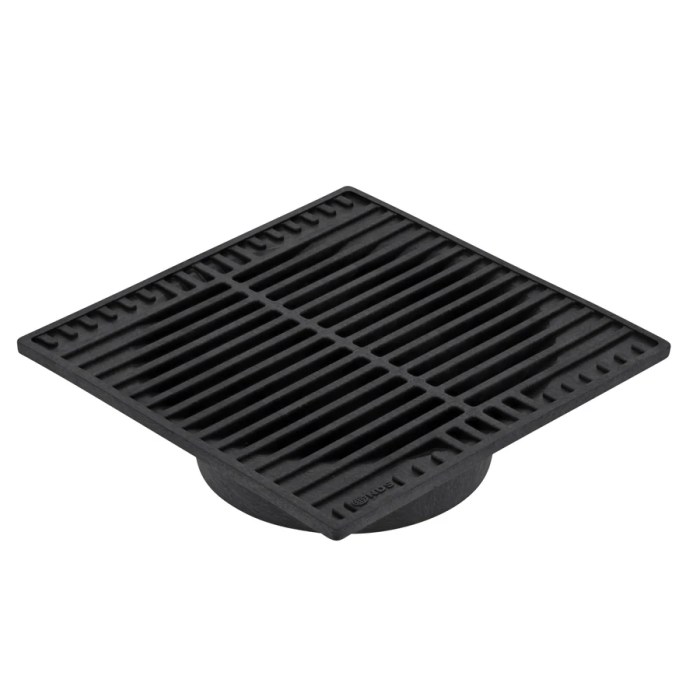Patio drain grates, an indispensable component of any outdoor space, seamlessly blend functionality and aesthetics. Their role extends beyond water drainage, as they also contribute to the overall design and ambiance of your patio.
From practical considerations to design elements, this comprehensive guide delves into the world of patio drain grates, empowering you to make informed choices that enhance the beauty and functionality of your outdoor oasis.
Patio Drain Grate Types
Patio drain grates are essential for directing water away from your patio and preventing flooding. They come in a variety of materials, each with its own advantages and disadvantages.
Plastic Patio Drain Grates
Plastic patio drain grates are a popular choice because they are lightweight, easy to install, and affordable. They are also available in a variety of colors and styles, so you can find one that matches your patio décor.
However, plastic patio drain grates are not as durable as metal or concrete grates. They can crack or break if they are subjected to heavy weight or impact.
Metal Patio Drain Grates
Metal patio drain grates are more durable than plastic grates, but they are also more expensive. They are typically made of galvanized steel or stainless steel, which is resistant to rust and corrosion.
Metal patio drain grates are also heavier than plastic grates, so they may be more difficult to install. However, they are less likely to crack or break, and they will last longer.
Concrete Patio Drain Grates
Concrete patio drain grates are the most durable type of grate, but they are also the most expensive. They are made of poured concrete, which is reinforced with steel rebar.
Concrete patio drain grates are very heavy, so they may be difficult to install. However, they are extremely durable and will last for many years.
Patio Drain Grate Installation
Installing a patio drain grate is a simple and straightforward process that can be completed in a few steps. By following these steps, you can ensure that your patio drain grate is installed correctly and will function properly for years to come.
Preparing the Installation Site
Before you begin installing your patio drain grate, it is important to prepare the installation site. This involves removing any debris or vegetation from the area where the grate will be installed. You should also make sure that the area is level and that there are no obstructions that could prevent the grate from being installed properly.
Securing the Grate in Place
Once the installation site has been prepared, you can begin securing the grate in place. This can be done using a variety of methods, including screws, bolts, or adhesive. The method you choose will depend on the type of grate you have and the surface to which it is being installed.
Once the grate has been secured in place, you should test it to make sure that it is functioning properly. This can be done by pouring water over the grate and observing how it drains. If the water drains properly, then your grate has been installed correctly.
Patio Drain Grate Maintenance
Regular maintenance is essential to keep patio drain grates functioning properly and prevent costly repairs or replacements. Here are some tips to ensure your grates stay in top condition:
Cleaning and Unclogging
Regular cleaning removes dirt, debris, and leaves that can clog the grates. Use a hose with a nozzle to spray away loose debris. For stubborn clogs, use a wire brush or a drain snake to clear the blockage.
Preventing Future Blockages
To prevent future blockages, install a drain grate cover or filter to catch debris before it reaches the grate. Regularly inspect the grates for any signs of damage or corrosion, and replace them as needed.
Patio Drain Grate Design
Patio drain grates not only serve a functional purpose but also contribute to the overall aesthetic of your outdoor space. Here are some design considerations to keep in mind when choosing a patio drain grate:
Material and Durability
Patio drain grates are typically made from cast iron, plastic, or stainless steel. Cast iron grates are durable and long-lasting, but they can rust over time. Plastic grates are lightweight and inexpensive, but they may not be as durable as cast iron or stainless steel.
Stainless steel grates are the most expensive option, but they are also the most durable and rust-resistant.
Shape and Size
Patio drain grates come in a variety of shapes and sizes. The shape of the grate should complement the overall design of your patio. For example, a square grate may look better on a modern patio, while a round grate may look better on a traditional patio.
The size of the grate should be large enough to allow water to drain freely, but not so large that it becomes a tripping hazard.
Style and Finish
Patio drain grates come in a variety of styles and finishes. The style of the grate should match the overall style of your patio. For example, a decorative grate may look better on a formal patio, while a more understated grate may look better on a casual patio.
The finish of the grate should be resistant to rust and corrosion.
Decorative Grates
Decorative patio drain grates can add a touch of style to your outdoor space. Decorative grates are available in a variety of designs, including floral, geometric, and animal motifs. They can be made from a variety of materials, including cast iron, plastic, and stainless steel.
Patio Drain Grate Applications
Patio drain grates find widespread applications in various settings, ranging from residential homes to commercial establishments and industrial facilities. Their primary purpose is to facilitate efficient drainage of water, preventing water accumulation and potential damage to patios and surrounding areas.
In residential settings, patio drain grates are commonly installed in outdoor patios, balconies, and decks. They help channel rainwater away from these surfaces, preventing waterlogging and the formation of puddles. This ensures a clean and safe outdoor space for relaxation and entertainment.
Commercial Applications
- Shopping malls and retail stores: Patio drain grates are used in outdoor walkways and courtyards to prevent water accumulation during rainfall. This ensures a safe and comfortable shopping experience for customers.
- Restaurants and cafes: Outdoor dining areas often feature patio drain grates to drain rainwater from patios and seating areas. This prevents water from pooling around tables and chairs, creating a more pleasant dining experience.
- Hotels and resorts: Patio drain grates are installed in outdoor patios, balconies, and pool decks to efficiently drain water and maintain a clean and inviting environment for guests.
Industrial Applications
- Warehouses and factories: Patio drain grates are used in loading docks and outdoor work areas to prevent water accumulation and ensure safe movement of goods and personnel.
- Industrial kitchens: Patio drain grates are installed in commercial kitchens to drain excess water from dishwashing areas and prevent slippery floors, ensuring a safe and hygienic work environment.
- Car washes: Patio drain grates are essential in car wash facilities to efficiently drain large volumes of water used during the washing process, preventing waterlogging and potential flooding.
Last Recap
In conclusion, patio drain grates are not merely utilitarian fixtures but versatile elements that can elevate the aesthetics and functionality of your outdoor space. By understanding the different types, installation techniques, maintenance requirements, and design considerations, you can harness the full potential of these often-overlooked components.
Whether you seek practical solutions for water drainage or aspire to create a visually stunning patio, this guide has equipped you with the knowledge and insights to make informed decisions. Embrace the transformative power of patio drain grates and unlock the full potential of your outdoor sanctuary.



